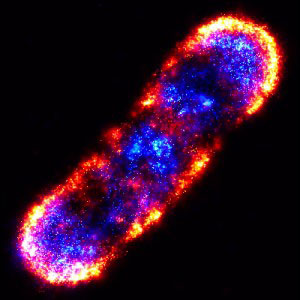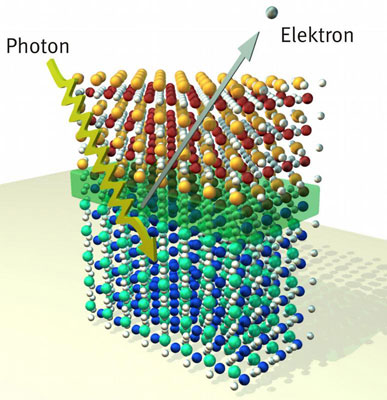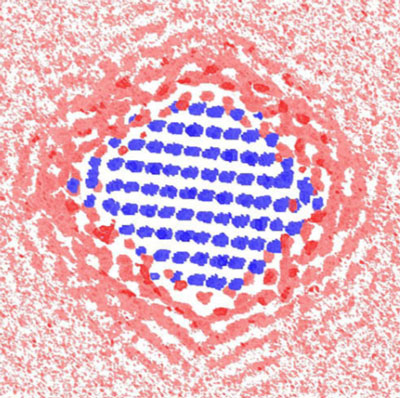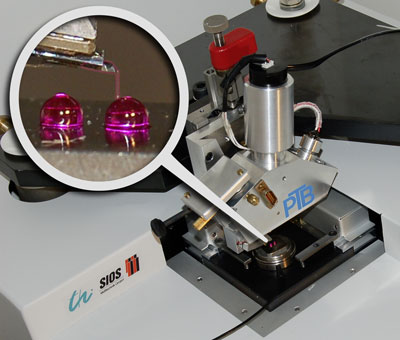Improving human health at the intersection of biology, chemistry and physics
 Where biology, chemistry and physics intersect, a Kansas State University professor expects to find applications to improve human health.
Where biology, chemistry and physics intersect, a Kansas State University professor expects to find applications to improve human health.
Jul 6th, 2009
Read more
 Where biology, chemistry and physics intersect, a Kansas State University professor expects to find applications to improve human health.
Where biology, chemistry and physics intersect, a Kansas State University professor expects to find applications to improve human health.
Jul 6th, 2009
Read more Self-assembling and self-organizing systems are the Holy Grails of nanotechnology, but nature has been producing such systems for millions of years. A team of scientists has taken a unique look at how thousands of bacterial membrane proteins are able to assemble into clusters that direct cell movement to select chemicals in their environment.
Self-assembling and self-organizing systems are the Holy Grails of nanotechnology, but nature has been producing such systems for millions of years. A team of scientists has taken a unique look at how thousands of bacterial membrane proteins are able to assemble into clusters that direct cell movement to select chemicals in their environment.
Jul 6th, 2009
Read more X-rays can be used to image hidden structures such as bones of the human body. But now, a team of physicists has succeeded in demonstrating the electronic structure of an interface in a solid for the first time
X-rays can be used to image hidden structures such as bones of the human body. But now, a team of physicists has succeeded in demonstrating the electronic structure of an interface in a solid for the first time
Jul 6th, 2009
Read moreA team of Canadian scientists and engineers, led by the University of Alberta and the National Research Council of Canada, will collaborate on a $3.39 million, three-year study to assess the potential effects of nanoparticles in specific water environments.
Jul 6th, 2009
Read more The red and blue images appear ghostly, like a fleeting glimpse of something that's never been seen before - which is true. Using computer simulations, Berkeley Lab scientists have developed the first predicted images of water molecules surrounding a nanoparticle, in this case an iron-oxide mineral called hematite.
The red and blue images appear ghostly, like a fleeting glimpse of something that's never been seen before - which is true. Using computer simulations, Berkeley Lab scientists have developed the first predicted images of water molecules surrounding a nanoparticle, in this case an iron-oxide mineral called hematite.
Jul 6th, 2009
Read moreResearchers at the U.S. Department of Energy's Savannah River National Laboratory have created a reversible route to generate aluminum hydride, a high capacity hydrogen storage material. This achievement is not only expected to accelerate the development of a whole class of storage materials, but also has far reaching applications in areas spanning energy technology and synthetic chemistry.
Jul 6th, 2009
Read more Scientists at the Physikalisch-Technische Bundesanstalt (PTB) have developed a metrological scanning probe microscope into a micro and nano coordinate measuring instrument.
Scientists at the Physikalisch-Technische Bundesanstalt (PTB) have developed a metrological scanning probe microscope into a micro and nano coordinate measuring instrument.
Jul 6th, 2009
Read moreRenesas Technology Corp., one of the world's leading semiconductor system solutions providers for mobile, automotive and PC/AV (Audio Visual) markets, has entered into a strategic research collaboration with IMEC, Europe's leading independent research center in the field of nanoelectronics, to perform research on 45nm RF transceivers targeting Gbit/s cognitive radios.
Jul 6th, 2009
Read more Scientists have developed an in vivo imaging method that offers a potentially safer and more stable alternative to current methods.
Scientists have developed an in vivo imaging method that offers a potentially safer and more stable alternative to current methods.
Jul 6th, 2009
Read moreThe Economist print edition of last week carries an article that describes how nano-engineering can produce materials with unique properties that will give renewable energy a boost.
Jul 6th, 2009
Read more Wie die Beh�rde f�r Wissenschaft und Forschung letzte Woche bekannt gab, wird der Exzellenzcluster 'Nano-Spintronik' im Rahmen der Hamburger Landesexzellenzinitiative ab sofort f�r zun�chst eineinhalb Jahre gef�rdert.
Wie die Beh�rde f�r Wissenschaft und Forschung letzte Woche bekannt gab, wird der Exzellenzcluster 'Nano-Spintronik' im Rahmen der Hamburger Landesexzellenzinitiative ab sofort f�r zun�chst eineinhalb Jahre gef�rdert.
Jul 6th, 2009
Read moreEurope's largest annual nanotechnology conference and exhibition, Nanotech Europe takes place in Berlin In its fifth year, Nanotech Europe will be held on 28 - 30 September 2009.
Jul 5th, 2009
Read moreHow nanoparticle toxicity affects the health and environment of Europeans is a concern that many researchers are currently investigating. Rising to the challenge is the NHECD ('Nano health-environment commented database') project, funded under the EU's Seventh Framework Programme to the tune of EUR 1.45 million. The project partners are seeking to create a critical and commented database on the health, safety and environmental impact of nanoparticles.
Jul 3rd, 2009
Read moreA collaborative effort between researchers from the London Centre for Nanotechnology, King's College London and UCL Chemistry has led to the first measurements of the electrostatic surface potential of individual DNA and avidin molecules with nanometre resolution using Kelvin Probe Force Microscopy in air.
Jul 3rd, 2009
Read moreIVAM Research has published the second edition of the "Nano Guide of Europe", a database which gives users an overview of what Europe's suppliers have to offer.
Jul 3rd, 2009
Read moreSwitzerland launches "Swiss Nano-Cube", the national information and learning platform dedicated to the topics of micro- and nanotechnologies for vocational schools, secondary schools and higher professional schools.
Jul 3rd, 2009
Read more